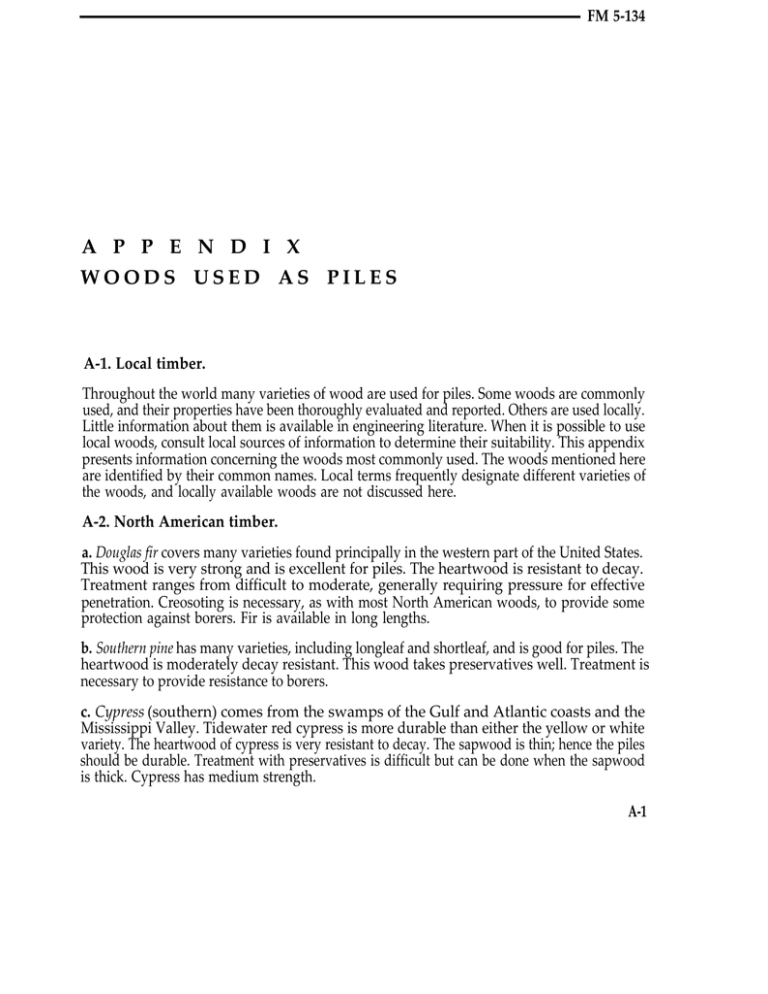A P P E N D I X
advertisement

FM 5-134 A P P E N D I X WOODS USED AS PILES A-1. Local timber. Throughout the world many varieties of wood are used for piles. Some woods are commonly used, and their properties have been thoroughly evaluated and reported. Others are used locally. Little information about them is available in engineering literature. When it is possible to use local woods, consult local sources of information to determine their suitability. This appendix presents information concerning the woods most commonly used. The woods mentioned here are identified by their common names. Local terms frequently designate different varieties of the woods, and locally available woods are not discussed here. A-2. North American timber. a. Douglas fir covers many varieties found principally in the western part of the United States. This wood is very strong and is excellent for piles. The heartwood is resistant to decay. Treatment ranges from difficult to moderate, generally requiring pressure for effective penetration. Creosoting is necessary, as with most North American woods, to provide some protection against borers. Fir is available in long lengths. b. Southern pine has many varieties, including longleaf and shortleaf, and is good for piles. The heartwood is moderately decay resistant. This wood takes preservatives well. Treatment is necessary to provide resistance to borers. c. Cypress (southern) comes from the swamps of the Gulf and Atlantic coasts and the Mississippi Valley. Tidewater red cypress is more durable than either the yellow or white variety. The heartwood of cypress is very resistant to decay. The sapwood is thin; hence the piles should be durable. Treatment with preservatives is difficult but can be done when the sapwood is thick. Cypress has medium strength. A-1 FM 5-134 d. Oak has been used for various types of short piles. Oak is expensive in many areas. There are many types of oak, varying in characteristics. Meet varieties are strong, durable, and quite resistant to decay. They must be creosoted to prevent borer attack, and the difficulty of treatment varies. Oak corrodes steel and iron. e. Lurch, a softwood which has moderate to high strength, is tough and durable, even when alternately wet and dry. It is difficult to treat with preservatives. Western larch, found in the United States, compares favorably with European larch. f. Redwood is a softwood of medium strength, not widely used for piles. It has little resistance to borers and can be treated with only moderate difficulty. g. Mangrove, palm, and palmetto have been used in the southern United States, principally because they have shown some resistance to attack by borers. They are very soft and are generally jetted into place, They are unable to withstand normal driving. Piles of this type have low strength and are used to support very light loads. They are susceptible to decay above the waterline. h. Other woods which have been used for piles are cedar, cottonwood, elm, various gums, and maple. A-3. Central and South American timber. a. Angelique is wood of Surinam which has considerable resistance to borers in tropical waters. It contains silica, which aids in borer resistance. b. Black kakarali is a hard, dense wood used in Guyana for waterfront structures. It has good resistance to borer attack. c. Foengo is from Surinam and has good resistance to borers in structures located in the Canal Zone. d. Greenheart from Guyana and Surinam is an excellent wood for piles for marine structures. It is resistant to borers, particularly in temperate zones. This is probably due to the alkaloid it contains. Greenheart is resistant to treatment since it is dense and close grained. e. Mahogany is an excellent wood for piles since it has high strength and durability. It is found in various parts of Central and South America. f. Manbarklak comes from Surinam. It is hard and heavy. It has a high silica content and offers good resistance to borer attack. It has good service records in both tropic and temperate waters. g. Mangrove, palm, and palmetto are used in various areas of Central and South America. h. Purpleheart is found in Trinidad, Guyana, French Guiana, and Surinam. It is resistant to decay, but more susceptible to borers than greenheart. A-2 FM 5-134 A-4. European timber. a. Larch is one of the toughest and most durable of the European woods. It is a softwood, although one of the denser and harder types. It can be treated with preservatives by pressure methods. b. Northern pine is given many local names and exists in several varieties. It is generally strong, elastic, and quite durable. c. Norway pine is similar to Northern pine and has medium strength. d. English oak is strong, tough, and durable. It is seldom available in long lengths and is expensive for ordinary use. It will corrode iron or steel fastenings. e. Alder is quite durable when completely submerged but susceptible to decay when alternately wet and dry. It is easy to treat and has moderate strength and resistance to borer attack. f. Elm is usually strong and tough. Some species are quite resilient, which has led to some use of piles of this type as fenders on waterfront structures. Elm is fairly durable and can be treated with preservatives, offering fair resistance to borers. g. Kail has low strength and is not widely used for piles when other woods are available. h. White deal has been used for piles, but has low strength. i. Many different firs, spruces, and pines are used locally in Europe, and some are exported. They are softwoods, but give reasonably good service when creosoted. A-5. African timber. Many different woods are used locally in Africa. Little information is available as to their properties. Local inquiry should be made to determine the suitability of a particular wood for use in pile structures. A-6. Asian timber. a. Teak is a hardwood found in many parts of Asia. It has high strength and durability and makes excellent piles where available. b. Eng is found in various countries and has been used as a substitute for teak. It has medium strength and durability when treated. c. Mahogany, found in various parts of Asia, is an excellent strong and durable wood for piles. It is extremely resistant to penetration of preservatives. Philippine mahogany is an example of this type of wood in Asia. A-3 FM 5-134 d. Sal is found in India and is used in waterfront structures. It has high strength and durability. e. Acle is found in India and has high strength and good resistance to borers. It is widely used in marine structures. f. Pyinkado is a Burmese hardwood having good strength and durability. It is extremely resistant to the penetration of preservative materials. g. Kolaka is found in the Celebes and is used for piles in Indonesia. It is high in silica content, thus is generally resistant to borers. h. Chir is Indian wood used for piles. It has medium strength. i. Deodar is used in India and has medium strength and durability. j. Peon is an Indian wood with medium strength and durability. k. Jarul is used to some extend in India and has high strength. l. White siris is an Indian wood of high strength and durability. A-7. Australian timber. a. Ironbark has medium strength and good durability. b. Jarrah is dense, impermeable wood. It has medium strength and high durability. c. Karri, for use in pile structures, has properties similar to those of jarrah. d. Tallow wood is a very dense, impermeable species having good durability. e. Turpentine wood is dense, impermeable, and durable. Resistance to borers lies in the properties of the bark, which must not be removed or damaged. f. White or red gum has medium strength and high durability. g. Totara is a New Zealand wood with good resistance to borer attack. h. Other woods are available in this area of the world. For example, Australia has many varieties of eucalyptus that are more resistant to borers than oak or pine. A-4





